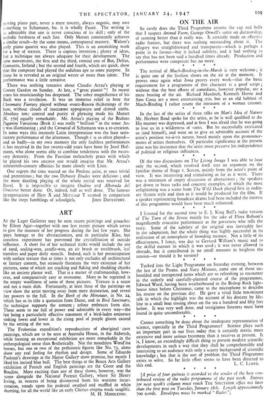ART
AT the Leger Galleries may be seen recent paintings and gouaches by Eileen Agar—together with one less recent picture which serves to give the measure of her progress during the last few years. She (pays homage to the abstractionists, and in particular Klee, but ceaseless experiment has prevented the crystallisation of outside influence. A short list of her technical tricks would include the use of sand, sealing-wax, candle-wax, an air brush or toothbrush, leaf transfers and paper doily stencils. Indeed, such is her preoccupation with surface texture that at times it not only excludes all architectural or literary content, but seriously threatens the very existence of her pictures, some of which are cracking and flaking and shedding chunks like an ancient plaster wall. That is a matter of craftsmanship, how- ever, and comparatively easy to overcome. More to be regretted is the empty woolliness of some of these pictures. Texture is a sauce and not a main dish. Fortunately, at least three of the paintings on view show the artist moving away from mere decoration, and reveal her powers to the full. In the Birth of the Minotaur, in No. 24, which has as its tide a quotation from Dante, and in Bird Sanctuary, the technique supports the content; embraces form also. These seem to me full of power and admirable in every way—the last being a particularly effective statement of a bird-laden eminence sinking lower and lower in the rising pool of purple gloom caused by the setting of the sun.
The Frobenius expedition's reproductions of aboriginal cave paintings, which are to be seen at Australia House, in the Aldwych, while forming an exceptional exhibition are more remarkable in the anthropological sense than aesthetically. Not the mouthless Wond'ina heroes, but one or two of the prehistoric figures like No. 73, alone show any real feeling for rhythm and design. Some of Eduardo Paolozzi's drawings at the Mayor Gallery show promise, but mostly I liked his incised blue bull. The best things at the Beaux Arts Gallery exhibition of French and English paintings are the Corot and the Boudins. More exciting than any of these shows, however, was the scene alongside the National Portrait Gallery, where Sir Henry Irving, in nrocess of being disinterred from. his wartime incar- ceration, stands upon his pedestal swathed and muffled in white sheeting, for all the world like an early Chirico enigma made tangible. M. H. MIDDLETON.


































 Previous page
Previous page